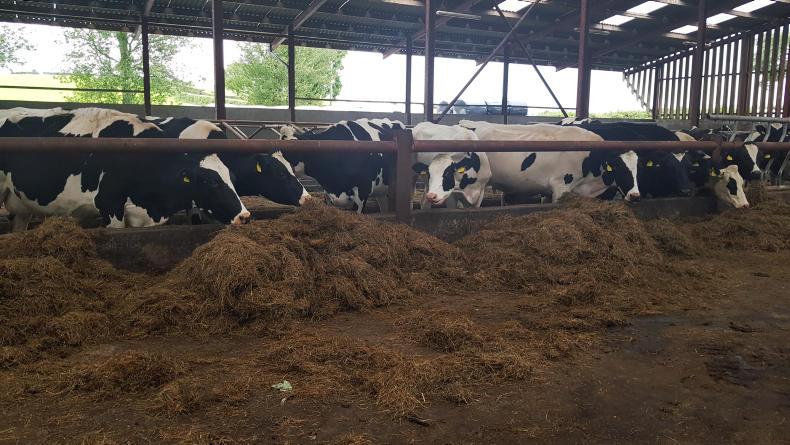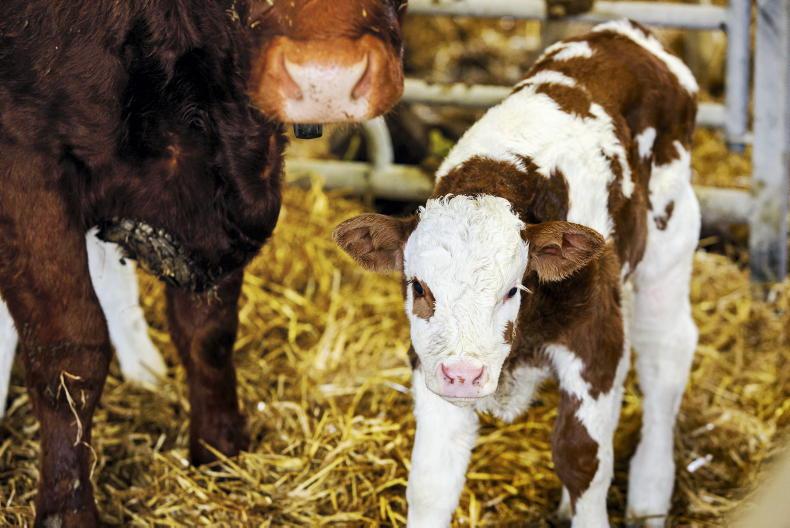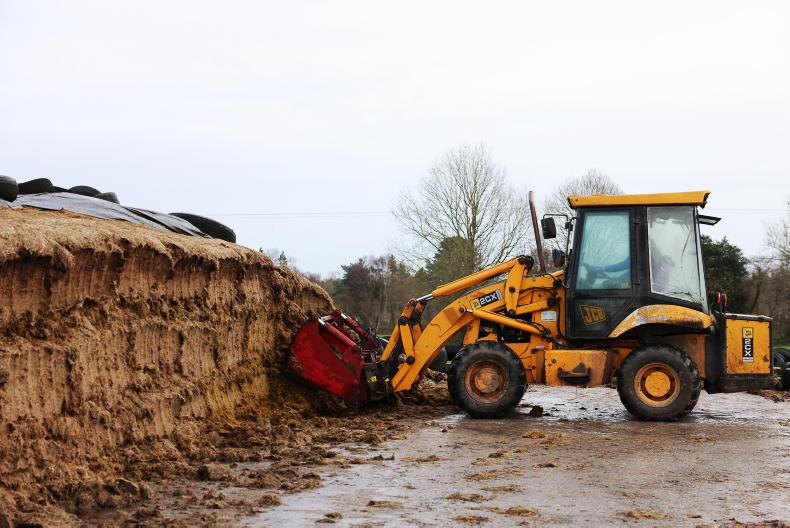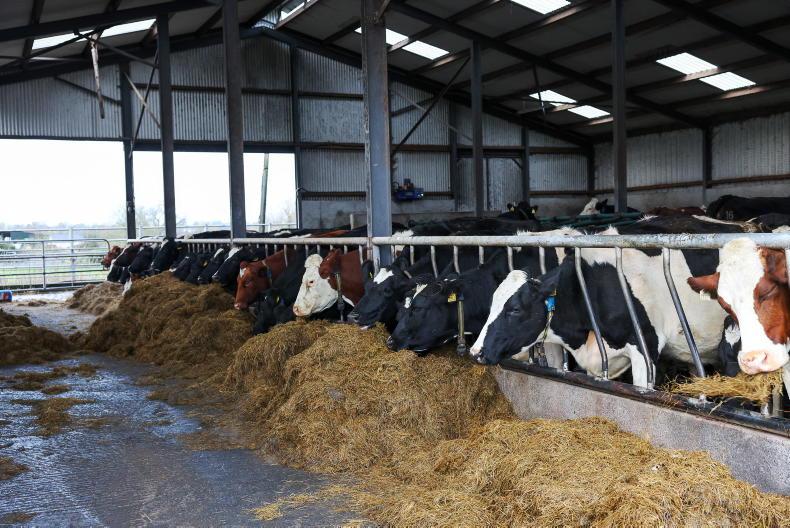Stale cows are continuing to be dried off at Stephen Wallace’s farm near Seaforde, Co Down. When we visited at the end of last week, 14 more cows had been selected and they were getting dry cow tubes and teat sealers, as well as treatments for fluke, worms and a vaccination for rotavirus.
The first cows that will be calving down from mid-September onwards have been housed for the last 30 days of the dry period and are on baled silage.
A dry cow blend is also being fed at a rate of 2kg/head/day for around four weeks before calving. The blend contains a mineral package and is made from good-quality ingredients with maize, barley and soya bean meal being the first three ingredients listed.
A few cows in the near group are slightly below the ideal body condition score at calving of 2.75 to 3.00.
Dairylink Ireland adviser Aidan Cushnahan said that these cows should not be fed extra dry cow concentrates during the last 30 days because it is unlikely to help body condition and will only increase calf birth weights, which could lead to calving difficulties.
His advice is to make sure that dry cows have adequate feed space (75cm/cow), so that intakes stay up and body condition does not drop further.
Freshly calved cows are fed above yield (lead fed) through in-parlour feeders, which should help hold body condition during early lactation.
Aidan said that body condition scores of late-lactation cows should be closely monitored, so that thinner cows can be dried off early or fed extra meal to help build condition ahead of calving.
He advises feeding at least an extra 3kg of meal to thinner cows, as most late-lactation cows will only produce more milk from an additional 1kg to 2kg and will not use it to put on condition.
Weekly round-up
Some programme farmers have been reseeding and putting in third-cut silage.The first cows have calved during the past week in some autumn-calving herds.Body condition scores of stale, dry and freshly calved cows are being closely monitored on Dairylink farms.Late-lactation cows with body condition score 2 to 2.25 will receive extra meal or will be dried off early.Farmers focus: Stephen Wallace, Seaforde, Co Down
Calving is due to start on Stephen Wallace’s farm on 16 September.

Niall McCarron from Lakeland Dairies, Aidan Cushnahan from CAFRE and host farmer Stephen Wallace during a visit to the farm last week.
There are more cows due to calve down over a shorter time this year, as Stephen has been taking steps to develop a block autumn-calving system.
There are several reasons for doing this:
More cows will be past peak lactation, settled in-calf and suitable for going to grass once conditions allow in the spring.Herd fertility will improve, as cows that are slow to get in-calf will leave the herd or at least won’t produce a replacement heifer.Heat detection and getting cows in-calf will be easier, as more cows will be eligible for AI over a shorter period.Overall, the workload will be more labour-efficient, as calving, calf rearing, heat detection and drying off become more seasonal tasks.There should be 19 cows calved by the end of September and 11 more will be calved by 10 October.
The plan is to keep all fresh-calved cows in full-time once there is a group of 30. Late-lactation cows will stay at grass until the end of October or early November if conditions allow.
There will be 110 cows calved by the end of November, 133 by the new year and calving will be finished by the end of January, with 186 cows calved.
Previously, the main bulk of calving ran from mid-September through to the end April.
Calf accommodation
There will be a higher labour demand during the autumn this year, as more cows calve down in a short time frame. This will also add to the demand for calf accommodation, which has led Stephen to explore options for getting more calf-rearing space.
In previous years, most calves were kept in individual pens up to weaning and were fed pasteurised milk from the bulk tank. However, he is considering batching some calves into groups this year to cut down labour requirements with feeding and bedding calves.
Some milk replacer will probably be fed to calves this year instead of whole milk to offset a hit in the milk cheque, particularly over the winter bonus period.
The main calf-rearing area is under the same roof as the cow cubicle house. It is airy and well-ventilated, but can be cold, so Stephen puts jackets on most calves. He will put up curtains and stock board to stop drafts blowing through the calf pens too.
There are few options for extra calf accommodation if space gets tight in the main calf house this year.
A shed beside the milking parlour, which is currently used for storage, has around 50m2 of space, which could accommodate a group of around 20 calves based on 2.5m2/calf.
As more cows are dried off, the quieter period will be used to get accommodation cleared, washed and disinfected ahead of calving.
Read more
Dairylink: a new phase gets under way
Dairylink: selecting cows for early grazing in Down
Reviewing replacement heifers in Down
Stale cows are continuing to be dried off at Stephen Wallace’s farm near Seaforde, Co Down. When we visited at the end of last week, 14 more cows had been selected and they were getting dry cow tubes and teat sealers, as well as treatments for fluke, worms and a vaccination for rotavirus.
The first cows that will be calving down from mid-September onwards have been housed for the last 30 days of the dry period and are on baled silage.
A dry cow blend is also being fed at a rate of 2kg/head/day for around four weeks before calving. The blend contains a mineral package and is made from good-quality ingredients with maize, barley and soya bean meal being the first three ingredients listed.
A few cows in the near group are slightly below the ideal body condition score at calving of 2.75 to 3.00.
Dairylink Ireland adviser Aidan Cushnahan said that these cows should not be fed extra dry cow concentrates during the last 30 days because it is unlikely to help body condition and will only increase calf birth weights, which could lead to calving difficulties.
His advice is to make sure that dry cows have adequate feed space (75cm/cow), so that intakes stay up and body condition does not drop further.
Freshly calved cows are fed above yield (lead fed) through in-parlour feeders, which should help hold body condition during early lactation.
Aidan said that body condition scores of late-lactation cows should be closely monitored, so that thinner cows can be dried off early or fed extra meal to help build condition ahead of calving.
He advises feeding at least an extra 3kg of meal to thinner cows, as most late-lactation cows will only produce more milk from an additional 1kg to 2kg and will not use it to put on condition.
Weekly round-up
Some programme farmers have been reseeding and putting in third-cut silage.The first cows have calved during the past week in some autumn-calving herds.Body condition scores of stale, dry and freshly calved cows are being closely monitored on Dairylink farms.Late-lactation cows with body condition score 2 to 2.25 will receive extra meal or will be dried off early.Farmers focus: Stephen Wallace, Seaforde, Co Down
Calving is due to start on Stephen Wallace’s farm on 16 September.

Niall McCarron from Lakeland Dairies, Aidan Cushnahan from CAFRE and host farmer Stephen Wallace during a visit to the farm last week.
There are more cows due to calve down over a shorter time this year, as Stephen has been taking steps to develop a block autumn-calving system.
There are several reasons for doing this:
More cows will be past peak lactation, settled in-calf and suitable for going to grass once conditions allow in the spring.Herd fertility will improve, as cows that are slow to get in-calf will leave the herd or at least won’t produce a replacement heifer.Heat detection and getting cows in-calf will be easier, as more cows will be eligible for AI over a shorter period.Overall, the workload will be more labour-efficient, as calving, calf rearing, heat detection and drying off become more seasonal tasks.There should be 19 cows calved by the end of September and 11 more will be calved by 10 October.
The plan is to keep all fresh-calved cows in full-time once there is a group of 30. Late-lactation cows will stay at grass until the end of October or early November if conditions allow.
There will be 110 cows calved by the end of November, 133 by the new year and calving will be finished by the end of January, with 186 cows calved.
Previously, the main bulk of calving ran from mid-September through to the end April.
Calf accommodation
There will be a higher labour demand during the autumn this year, as more cows calve down in a short time frame. This will also add to the demand for calf accommodation, which has led Stephen to explore options for getting more calf-rearing space.
In previous years, most calves were kept in individual pens up to weaning and were fed pasteurised milk from the bulk tank. However, he is considering batching some calves into groups this year to cut down labour requirements with feeding and bedding calves.
Some milk replacer will probably be fed to calves this year instead of whole milk to offset a hit in the milk cheque, particularly over the winter bonus period.
The main calf-rearing area is under the same roof as the cow cubicle house. It is airy and well-ventilated, but can be cold, so Stephen puts jackets on most calves. He will put up curtains and stock board to stop drafts blowing through the calf pens too.
There are few options for extra calf accommodation if space gets tight in the main calf house this year.
A shed beside the milking parlour, which is currently used for storage, has around 50m2 of space, which could accommodate a group of around 20 calves based on 2.5m2/calf.
As more cows are dried off, the quieter period will be used to get accommodation cleared, washed and disinfected ahead of calving.
Read more
Dairylink: a new phase gets under way
Dairylink: selecting cows for early grazing in Down
Reviewing replacement heifers in Down










SHARING OPTIONS